- Submissions

Full Text
Modern Concepts & Developments in Agronomy
Tractor on Electric Traction with a Backup Gas Turbine Engine
VA Gusarov*
Federal Scientific Agroengineering Center VIM, Moscow, Russia
*Corresponding author: VA Gusarov, Federal Scientific Agroengineering Center VIM, Moscow, Russia
Submission: April 29, 2022;Published: May 18, 2022

ISSN 2637-7659Volume10 Issue 5
Abstract
This work is devoted to scientific research carried out on the basis of the T-16 tractor self-propelled chassis, according to the developed new kinematic scheme, not previously used in the Russian tractor industry. The proposed new kinematic scheme includes an electric drive with frequency control with a power of 11kW, powered by a battery with a nominal voltage of 480V, a standard six-speed manual transmission, a parallel power supply source, which is a gas turbine power generator designed to charge batteries in the field, move the tractor and power the external loads with standard voltage. The proposed kinematic scheme is more reliable in terms of technical operation, provides more comfortable working conditions for machine operators, improves the local environmental situation, and ensures the economic efficiency of technological cycles. The paper provides a description of the proposed kinematic diagram of the tractor, the technical characteristics of units, assemblies and their work schedules. The technical characteristics of the torque of the electric motor, which was replaced by a diesel engine, are presented. The positive aspects of the tractor on electric traction are shown, its design is presented.
Keywords: Tractor; Storage battery; Frequency regulation; Asynchronous electric motor; Gas turbine power generator; Thermal energy; Electric power
Introduction
Now in the world there is an increase in vehicles with electric drive and batteries [1-4]. Passenger cars are produced in large numbers, of various capacities, differing structurally, in terms of battery capacity, and comfort level [5-9]. It is known that in factories and warehouses, for lifting and transporting goods, vehicles powered by batteries are used [10-13]. In many countries, research is being funded to develop technological transport for agriculture, road and public works, loading and harvesting equipment [14-17]. All these machines have a different design of electric motors, power, battery capacity and kinematic schemes, as they perform different operations [7,18-20].
Figure 1: Tractor T-16.

For experimental studies on the use of a new kinematic scheme, the T-16 tractor was chosen, designed for transport work on the transportation of goods weighing 1000kg, performing field technological operations, and plowing light soils. The power plant is a diesel two-cylinder engine with a power of 16kW and a maximum torque of 89Nm. The transmission consists of a mechanical gearbox with six gears forward, one reverse, one downshift with blocking of the rear drive wheels. Drive wheels are mounted on final drives. Figure 1 shows the T-16 tractor.
Research task. The scientific task is to develop a new kinematic scheme with an electric drive for this tractor. Initially, the diesel engine and clutch basket were dismantled. The total weight of the dismantled equipment is 360kg. Technical documentation has been developed for connecting an asynchronous electric motor to the input shaft of the gearbox through an adapter. In accordance with the project, the tractor is equipped with a battery to power the electric motor and a backup gas turbine generator to charge the batteries. The general block diagram of a tractor with an electric drive and a gas turbine generator is shown in Figure 2. The choice of the electric motor was determined by the technical characteristics, which must correspond to those of the diesel engine.
Figure 2: Block diagram of tractor units.
1. Network charger;
2. Rechargeable batteries;
3. Control unit for the rotation of the electric motor;
4. Asynchronous electric motor;
5. Fuel tank;
6. Gas turbine engine;
7. Electric generator;
8. Charger from the turbogenerator;
9. Inverter;
10. External electrical load connection cabinet.
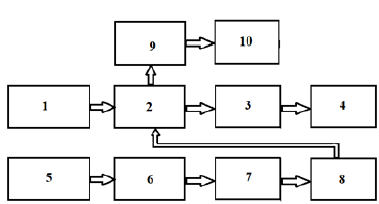
Theoretical calculation
For installation on a tractor, an asynchronous electric motor AIR 132-M4 with a power of 11kW and a rotation speed of 1430rpm was selected. at 50Hz. The change in speed is made by the Goodrive 200A frequency controller with a power of 15kW. The rated torque of the squirrel-cage induction motor is 73.3Nm, the maximum torque can be 50 to 100% more. Figure 3 compares the characteristics of a diesel engine with maximum torque and an induction motor with rated and maximum torque and speed.
Figure 3: Torque characteristics of diesel and asynchronous motors.
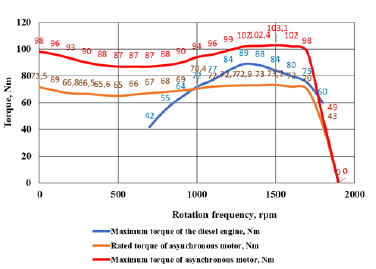
The diesel engine has a maximum speed of 1800rpm. To create a rotational speed of an asynchronous motor of 1800rpm. the maximum frequency of rotation of the electromagnetic field is set to 65Hz on the frequency regulator. The battery pack is installed under the cargo platform and is shown in Figures 3&4.
Figure 4: Battery pack.
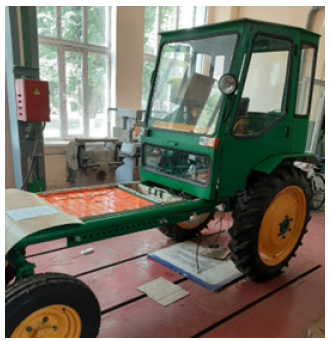
The unit consists of 40 series-connected “Delta 20-12” batteries with a capacity of 20Ah, rated voltage 480V. These batteries are charged from a centralized network with a voltage of 230V through an on-board automatic charger up to a voltage of 540V. The energy of a charged battery is 10kWh. In order to avoid battery discharge, in the field there is a gas turbine electric generator on board the tractor, it simultaneously provides battery charging, tractor movement, power supply to the connected external load with an alternating three-phase voltage of 380V. The kinematic diagram of the gas turbine power generator is shown in Figure 5. The gas turbine engine operates on the Brayton cycle.
Figure 5:Kinematic diagram of a gas turbine generator.
1. Input starting device;
2. Radial compressor;
3. Combustion chamber;
4. Centripetal turbine;
5. Three-stage free power turbine;
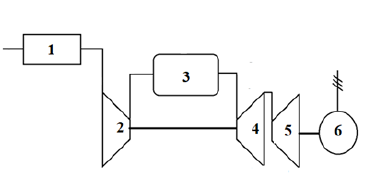
In accordance with the technical characteristics of the radial compressor and the centripetal turbine, the performance is determined, NВ, g/s, [21].

Nel - power plant capacity, 11kW;
Qt -is the specific heat of combustion of kerosene, 13,0 kWh/
kg, [22];
L0 -air consumption required for the combustion of propanebutane,
15,0, kg/kg;
η -is the theoretical electrical efficiency of the turbogenerator,
25%;
ηeg -is the efficiency of the electric generator, 0,75, [23];
ηsst -is the efficiency of a three-stage free turbine, 0,75, [24];
P -Theoretical coefficient of compressor work, 0.7, [25].
αob - coefficient of excess air, 8.0;
The design capacity of the compressor is not less than, kg/s:

A free three-stage turbine has been developed, placed on one
disk and with the direction of rotation opposite to the rotation of
the rotor of the gas turbine engine, has the initial data:
1. turbocharger speed n1= 30000÷96000rpm;
2. free turbine output shaft speed n2В = 2000÷4000rpm;
3. fuel consumption GT = 2,5 g/s;
4. air consumption NB = 170g/s = 0,17kg/s;
Circumferential speed on the middle diameter for the first stage in the hot state, V1 st, m/s:


Circumferential speed on the middle diameter for the second stage in a hot state, V2st, m/s:


Circumferential speed on the middle diameter for the third stage in a hot state, V3st, m/s:


Actual gas expansion work in the turbine, , :


Estimated power developed by a free turbine, kW:


Figure 6 shows a gas turbine power generator mounted on a tractor.
Figure 6:Gas turbine electric generator on a tractor.
1. Gas turbine engine;
2. Three-stage free turbine;
3. Asynchronous electric generator;
4. Switching cabinet for external connections;
5. Air cleaner; 6. Power asynchronous electric motor.
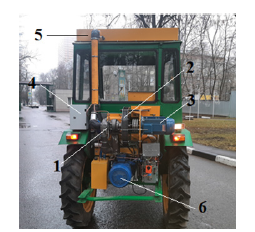
An inverter with an output voltage of 230V and a power of 3kW is connected to the battery, which is necessary to power the gas turbine engine start system and power an external load with a voltage of 220V.
The communication cabinet contains: a connector for charging the battery, for connecting an external load, a single-phase 230V socket and a three-phase 380V socket.
Exhaust gas temperature is 440 ℃, gas quantity is 1040m3/h. The mass of the installed equipment, including the battery pack, power asynchronous electric motor, gas turbine power generator, electronic devices and equipment, is 346kg.
Experimental studies
The first sea trials were carried out on a flat paved area without cargo. The results of the experimental studies are presented in Table 1.
The operating time of the tractor with uniform movement on a horizontal asphalt road, with a load of 500kg, in 4th gear, a speed of 11km/h and a temperature of 17 ℃ is 4 hours 46 minutes. The graph of the dynamics of the speed of rotation of the rotor of the power electric motor over time when the pedal is fully depressed is shown in Figure 7.
Table 1: Results of running experimental studies.

Figure 7:Graph of the dynamics of the rotor speed asynchronous power motor.
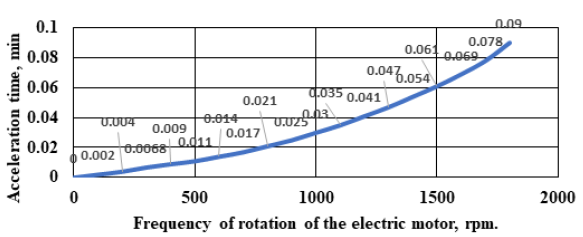
Such dynamics of the action of the electric motor on the standard gearbox does not depend on the behavior of the driver and prevents the effect of high torque on the main and final drives of the transmission, ensuring high reliability and a longer service life of these units. The forced stop of the tractor by the electric motor, with a sharp decrease in the engine speed, is set to two seconds by default, but experimental studies have shown that it is possible to stop from 18km/h to 0km/h in 4,5 s. Figure 8 shows a graph of the change in the speed of the tractor when braking by the electric motor.
Figure 8:Graph of the change in the speed of the tractor when braking by the electric motor.
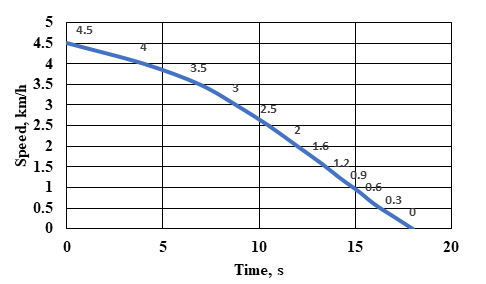
Conclusion
The modernized tractor has more opportunities to perform various agricultural technological operations compared to its analogue, using mechanical, thermal and electrical energy for external consumers becomes the most cost-effective. Its application in agricultural technological operations associated with the use of heat, heat treatment is possible, which improves the storage conditions of grain crops, drying of hay and straw. Heat treatment is used to improve the quality of food and feed. Heat treatment includes: boiling, frying, sterilization of vegetables and fruits, pasteurization of milk, juices, wines, steaming of feed. The generated standard voltage electricity can be used to power water pumps, field repair shops, connect cow milking machines, sheep shearers, fans.
References
- Kougias I, Nikitas A, Thiel C, Szabó S (2020) Clean energy and transport pathways for islands: A stakeholder analysis using Q method. Transportation Research Part D: Transport and Environment 78: 102180.
- Vala D, Friedrischkova K (2018) Development of the methodology for the management of the electromobile system and the family house system. Photonics Applications in Astronomy, Communications, Industry, and High-Energy Physics Experiments 2018, Wilga, Poland, p. 146.
- Kim SY, Cho JH, Murray E, Bakh N, Choi H, et al. (2015) Stochastic electrotransport selectively enhances the transport of highly electromobile molecules. National Library of Medicine 11: 10.
- Strizhevsky AM, Gotsev AA (2016) Operation of electric vehicles: advantages and problems. Problems of implementing the results of innovative developments. Limited Liability Company, Chelyabinsk, Russia pp: 50-52.
- Pattarakunnan K, Galos J, Das R, Mouritz AP (2021) Impact damage tolerance of energy storage composite structures containing lithium-ion polymer batteries. Composite Structures 267: 113845.
- Junyan C, Yang Z, Islam MS, Cheng X, Brown SA, et al. (2020) Carbon fiber reinforced Zn-MnO2 structural composite batteries. Composites Science and Technology 209: 108787.
- Yan Z, Zhao T, Xu Y, Koh LH, Go J, et al. (2020) Data-driven robust planning of electric vehicle charging infrastructure for urban residential car parks. IET Generation Transmission & Distribution 14(26): 6545-6554.
- Irshad UB, Rafique S, Town G (2020) Stochastic modeling of electric vehicle behavior to estimate available energy storage in parking lots. IET Smart Grid 3(6): 760-767.
- Morlock F, Rolle B, Bauer M, Sawodny O (2020) Time optimal routing of electric vehicles under consideration of available charging infrastructure and a detailed consumption model. IEEE Transactions on Intelligent Transportation Systems 21(12): 5123-5135.
- Hirz M, Walzel B, Helmut B (2021) Autonomous charging of electric vehicles in industrial environment. Tehnicki Glasnik-Technical Journal15(2): 220-225.
- Braam ITJ, van Dormolen M, Dresen MHWF (1996) The workload of warehouse workers in three different working systems. International Journal of Industrial Ergonomics 17(6): 469-480.
- Thiede S, Turetskyy A, Arno K, Kara S, Herrmann C (2019) Data mining in battery production chains towards multi-criterial quality prediction. CIRP Annals 68(1): 463-466.
- Simpson TW, Medeiros DJ, Joshi S, Lehtihet A, Wysk RA (2004) A new course for integrating design, manufacturing and production into the engineering curriculum. International Journal of Engineering Education 20(5): 764-776.
- Lin BR (2021) Analysis and implementation of a frequency control DC-DC Converter for Light Electric Vehicle Applications. Electronics 10(14): 1623.
- Liu X, Sun X, Zheng H, Huang D (2021) Do policy incentives drive electric vehicle adoption? Evidence from China. Transportation Research Part A: Policy and Practice 150: 49-62.
- Xu L, Chen K, Chen GQ, Kentish SE, Li G (2021) Development of barium @ alginate adsorbents for sulfate removal in lithium refining. Frontiers of Chemical Science and Engineering 15(1): 198-207.
- Gusarov VA, Godzhaev ZA, Gusarova EV (2020) The prospect of using gas turbine power plants in the agricultural sector. AMA-Agricultural Mechanization in Asia Africa and Latin America 51(3): 19-23.
- Sierra A, Reinders A (2021) Designing innovative solutions for solar-powered electric mobility applications. Progress in Photovoltaics 29(7): 802-818.
- Caggiani L, Prencipe LP, Michele O (2021) A static relocation strategy for electric car-sharing systems in a vehicle-to-grid framework. Transportation Letters-The International Journal of Transportation Research 13(3): 219-228.
- Changizian S, Pouria A, Raeesi M, Javani N (2020) Performance optimization of hybrid hydrogen fuel cell-electric vehicles in real driving cycles. International Journal of Hydrogen Energy 45(60): 35180-35197.
- Gusarov VA (2015) Creation of a micro gas turbine engine based on an internal combustion engine turbocharger. In: Gusarov VA, Ya V (Eds.), Industrial Energy 10: 51-54.
- (1999) Physical encyclopedia. In: Prokhorov AM (Ed.), Soviet Encyclopedia, p. 5.
- (2010) Technical catalog of electric motors of the Vladimir Motor Plant. In: Vladimir VMZ (Ed.).
- Yablokov LD (1988) Steam and gas turbine installations: a textbook for energy and energy construction technical schools. Yablokov LD (Ed.), Energoatomizdat, Moscow, Russia.
- Bartosh ET (1972) Gas turbines in railway transport. In: Bartosz ET (Ed.), Transport, Moscow, Russia.
© 2022 VA Gusarov. This is an open access article distributed under the terms of the Creative Commons Attribution License , which permits unrestricted use, distribution, and build upon your work non-commercially.
 a Creative Commons Attribution 4.0 International License. Based on a work at www.crimsonpublishers.com.
Best viewed in
a Creative Commons Attribution 4.0 International License. Based on a work at www.crimsonpublishers.com.
Best viewed in 







.jpg)






























 Editorial Board Registrations
Editorial Board Registrations Submit your Article
Submit your Article Refer a Friend
Refer a Friend Advertise With Us
Advertise With Us
.jpg)






.jpg)














.bmp)
.jpg)
.png)
.jpg)










.jpg)






.png)

.png)



.png)






